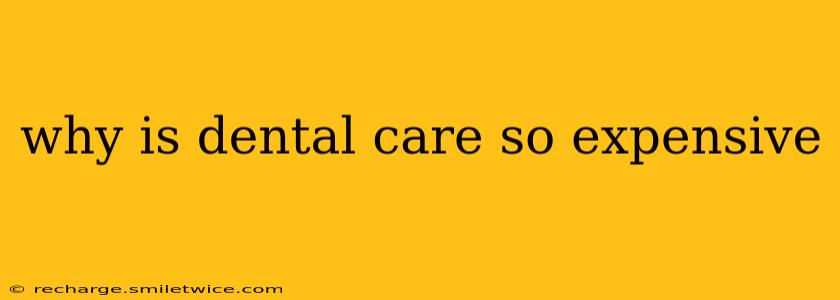Dental care costs can seem exorbitant, leaving many wondering why seemingly simple procedures carry such hefty price tags. The high cost isn't due to a single factor but rather a confluence of several intertwined issues. This article explores the key reasons behind the expense of dental care, offering a comprehensive understanding of this complex topic.
What Factors Contribute to the High Cost of Dental Care?
Several factors contribute to the high cost of dental care, making it a significant expense for many individuals and families. Let's break down the key players:
1. High Educational Costs and Specialized Training: Becoming a dentist requires extensive education and training. Years of rigorous study at university, followed by specialized dental school, results in substantial student loan debt for dentists. These debts influence their fee structure, as dentists need to recoup their investment. The high level of skill and precision required for successful dental practice also factors into the cost.
2. Advanced Technology and Equipment: Modern dentistry utilizes advanced technology and equipment, from sophisticated imaging systems (like digital X-rays and CBCT scans) to laser dentistry and CAD/CAM (computer-aided design/computer-aided manufacturing) for creating restorations. This technology, while improving patient care, comes with significant upfront and ongoing costs, which are passed on to the patient.
3. Overhead Costs of Running a Dental Practice: Dental practices have significant overhead costs, including rent or mortgage payments for office space, utilities, staff salaries (hygienists, assistants, receptionists), insurance, marketing, and maintaining the expensive equipment mentioned above. These fixed costs are substantial and must be factored into the price of services.
4. Insurance Coverage and Payment Plans: While dental insurance can help alleviate some of the costs, it often doesn't cover all procedures or materials, leaving patients with significant out-of-pocket expenses. Furthermore, insurance companies negotiate rates with dentists, which can impact the overall profitability of the practice, influencing fees. The complexity of insurance claims processing also adds to administrative costs.
Why Aren't Dental Procedures Covered by Health Insurance Like Medical Care?
This is a common question. Historically, dental care has been considered a separate branch of healthcare, resulting in its exclusion from many comprehensive health insurance plans. This is slowly changing, but the legacy of separation continues to impact coverage.
How Can I Find Affordable Dental Care?
Finding affordable dental care requires research and planning:
- Look for Dental Schools: Dental schools often offer services at reduced rates, as students perform procedures under the supervision of experienced faculty.
- Dental Discount Plans: These plans provide access to dental services at discounted rates. However, carefully research the specifics of each plan to understand the services covered.
- Community Health Centers: Many communities have health centers offering low-cost or sliding-scale dental services based on income.
- Negotiate Payment Plans: Discuss payment options with your dentist. They may offer payment plans to help manage the costs.
- Shop Around: Get quotes from several dentists before committing to treatment.
What are some ways to prevent costly dental problems?
Proactive dental care is crucial in preventing expensive problems down the line:
- Regular Checkups and Cleanings: Preventative care through regular visits is the most effective way to prevent larger, costlier issues from developing.
- Proper Oral Hygiene: Brushing and flossing twice daily are fundamental to maintaining healthy teeth and gums.
- Healthy Diet: Limiting sugary foods and drinks reduces the risk of cavities.
Conclusion
The high cost of dental care is a multifaceted problem arising from educational costs, technology, overhead, and insurance complexities. While expensive, proactive care and smart planning can help mitigate some of the financial burden. By understanding these factors, patients can make informed decisions about their oral health and access affordable dental care.
